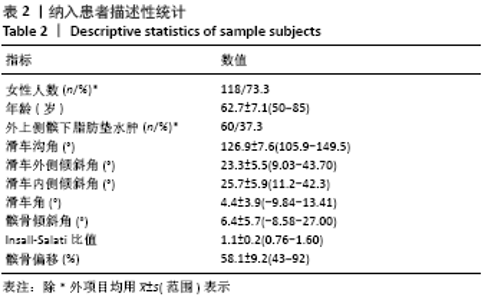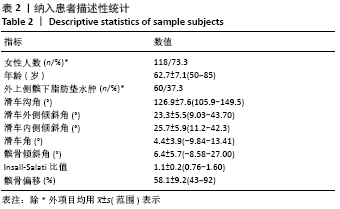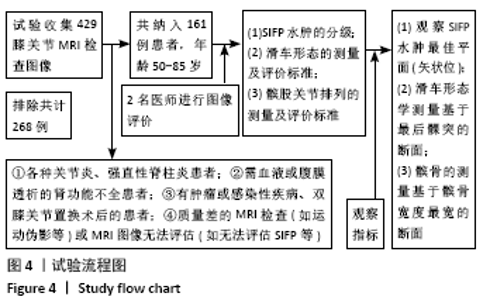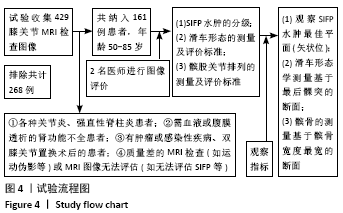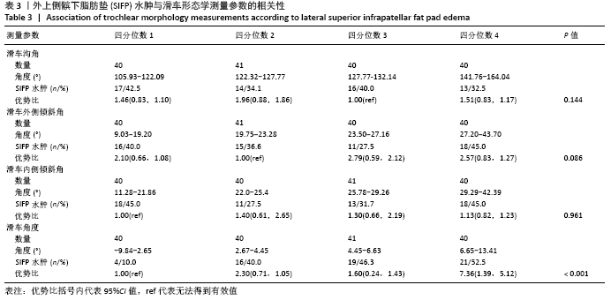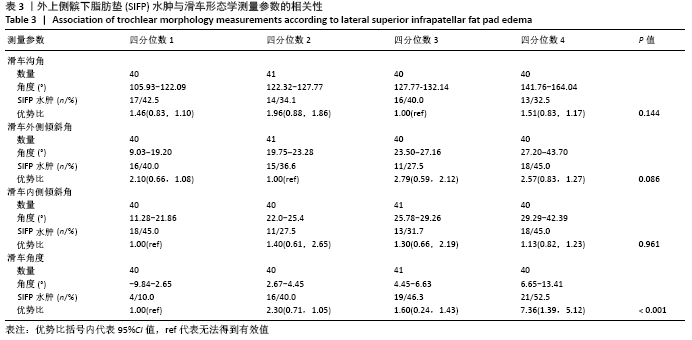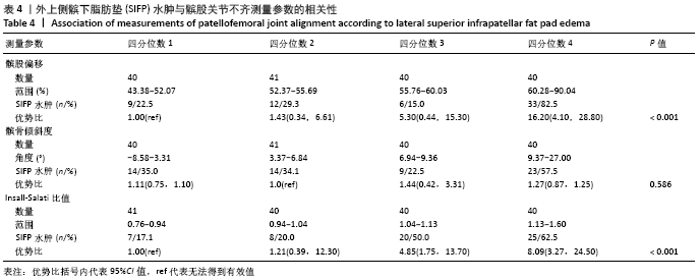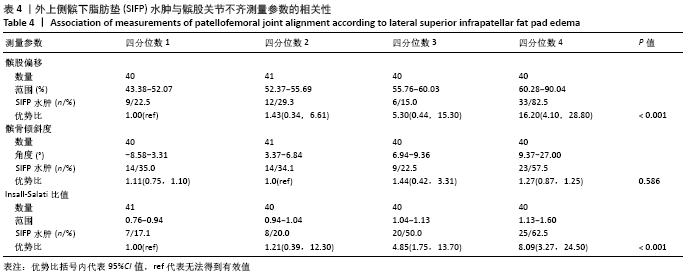[1] HARKEY MS, DAVIS JE, LU B, et al. Early pre-radiographic structural pathology precedes the onset of accelerated knee osteoarthritis. BMC Musculoskelet Disord. 2019;20(1):241.
[2] ROEMER FW, JARRAYA M, FELSON DT, et al. Magnetic resonance imaging of Hoffa’s fat pad and relevance for osteoarthritis research: a narrative review. Osteoarthritis Cartilage. 2016;24(3):383-397.
[3] MATHIESSEN A, CONAGHAN PG. Synovitis in osteoarthritis: current understanding with therapeutic implications. Arthritis Res Ther. 2017; 19(1):18.
[4] YI J, LEE YH, SONG HT, et al. Double-inversion recovery with synthetic magnetic resonance: a pilot study for assessing synovitis of the knee joint compared to contrast-enhanced magnetic resonance imaging. Eur Radiol. 2019;29(5):2573-2580.
[5] CHUNG CB, SKAF A, ROGER B, et al. Patellar tendon-lateral femoral condyle friction syndrome: MR imaging in 42 patients. Skeletal Radiol. 2001;30(12):694-697.
[6] HAJ-MIRZAIAN A, GUERMAZI A, PISHGAR F, et al. Patellofemoral morphology measurements and their associations with tibiofemoral osteoarthritis-related structural damage: exploratory analysis on the osteoarthritis initiative. Eur Radiol. 2020;30(1):128-140.
[7] BROSSMANN J, MUHLE C, SCHRODER C, et al. Patellar tracking patterns during active and passive knee extension: evaluation with motion-triggered cine MR imaging. Radiology. 1993;187(1):205-212.
[8] 廖焕元,程启彬,黄莲珍,等. MSCT各测量指标对髌股关节不稳的诊断价值[J]. 吉林医学,2019,40(2):304-307.
[9] TAN SHS, IBRAHIM MM, LEE ZJ, et al. Patellar tracking should be taken into account when measuring radiographic parameters for recurrent patellar instability. Knee Surg Sports Traumatol Arthrosc. 2018;26(12): 3593-3600.
[10] MARZO JM, KLUCZYNSKI MA, NOTINO A, et al. Measurement of tibial tuberosity-trochlear groove offset distance by weightbearing cone-beam computed tomography scan. Orthop J Sports Med. 2017;5(10): 2325967117734158.
[11] 王娟,张家雄,周守国. Hoffa病与髌骨运动轨迹异常相关性的MRI研究[J]. 放射学实践,2014,29(4):428-432.
[12] EIJKENBOOM JFA, VAN DER HEIJDEN RA, DE KANTER JLM, et al. Patellofemoral alignment and geometry and early signs of osteoarthritis are associated in patellofemoral pain population. Scand J Med Sci Sports. 2020;30(5):885-893.
[13] WIDJAJAHAKIM R, ROUX M, JARRAYA M, et al. Relationship of trochlear morphology and patellofemoral joint alignment to superolateral hoffa fat pad edema on mr images in individuals with or at risk for osteoarthritis of the knee: the most study. Radiology. 2017;284(3): 806-814.
[14] LI J, SHENG B, LIU X, et al. Sharp margin of antero-inferior lateral femoral condyle as a risk factor for patellar tendon-lateral femoral condyle friction syndrome. Eur Radiol. 2020;30(4):2261-2269.
[15] INSALL J, SALVATI E. Patella position in the normal knee joint. Radiology. 1971;101(1):101-104.
[16] Stefanik JJ, Zumwalt AC, Segal NA, et al. Association between measures of patella height, morphologic features of the trochlea, and patellofemoral joint alignment: the MOST study. Clin Orthop Relat Res. 2013;471(8):2641-2648.
[17] 孙明会,匡长福. MRI扫描对髌股关节骨性关节炎临床诊断价值研究[J]. 世界最新医学信息文摘,2019,19(34):185+187.
[18] Weintraub S, Sebro R. Superolateral Hoffa’s Fat Pad Edema and Trochlear Sulcal Angle Are Associated With Isolated Medial Patellofemoral Compartment Osteoarthritis. Can Assoc Radiol J. 2018; 69(4):450-457.
[19] Kim JH, Lee SK, Jung JY. Superolateral Hoffa’s fat pad oedema: Relationship with cartilage T2* value and patellofemoral maltracking. Eur J Radiol. 2019;118:122-129.
[20] 王小龙,刘云鹏,华国军,等. 国人髌股关节稳定性的CT扫描参数判断[J]. 安徽医药,2019,23(10):1952-1955+2123.
[21] SVENSSON F, FELSON DT, ZHANG F, et al. Meniscal body extrusion and cartilage coverage in middle-aged and elderly without radiographic knee osteoarthritis. Eur Radiol. 2019;29(4):1848-1854.
[22] MATCUK GR JR, CEN SY, KEYFES V, et al. Superolateral hoffa fat-pad edema and patellofemoral maltracking: predictive modeling. AJR Am J Roentgenol. 2014;203(2):W207-212.
[23] 李宁,蓝星,方晓堃,等. MRI定量分析髌股关节形态与髌骨软化症之间相关性研究[J]. 医学影像学杂志,2020,30(2):312-315.
[24] JIBRI Z, MARTIN D, MANSOUR R, et al. The association of infrapatellar fat pad oedema with patellar maltracking: a case-control study. Skeletal Radiol. 2012;41(8):925-931.
[25] BARBIER-BRION B, LERAIS JM, AUBRY S, et al. Magnetic resonance imaging in patellar lateral femoral friction syndrome (PLFFS): prospective case-control study. Diagn Interv Imaging. 2012;93(3): e171-182.
[26] 侯俊鹏,王刚涛,夏磊,等. 髌骨内移对髌股关节压力影响的试验研究[J]. 中国骨与关节损伤杂志,2019,34(1):17-20.
[27] WU S, BA H, HE J, et al. A cross-sectional study on the correlation between MRI signal for IPFP and knee osteoarthritis. Zhong Nan Da Xue Xue Bao Yi Xue Ban. 2017;2(5):536-541.
[28] CAMPAGNA R, PESSIS E, BIAU DJ, et al. Is superolateral Hoffa fat pad edema a consequence of impingement between lateral femoral condyle and patellar ligament? Radiology. 2012;263(2):469-474.
|
